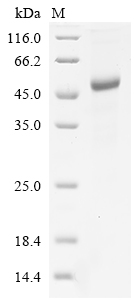Recombinant Human Actin-like protein 6B (ACTL6B)
CAT:
399-CSB-EP001237HU-02
Size:
100 µg
Price:
Ask
- Availability: 24/48H Stock Items & 2 to 6 Weeks non Stock Items.
- Dry Ice Shipment: No




Recombinant Human Actin-like protein 6B (ACTL6B)
- CAS Number: 9000-83-3
- Gene Name: ACTL6B
- UniProt: O94805
- Expression Region: 1-426aa
- Organism: Homo sapiens
- Target Sequence: MSGGVYGGDEVGALVFDIGSFSVRAGYAGEDCPKADFPTTVGLLAAEEGGGLELEGDKEKKGKIFHIDTNALHVPRDGAEVMSPLKNGMIEDWECFRAILDHTYSKHVKSEPNLHPVLMSEAPWNTRAKREKLTELMFEQYNIPAFFLCKTAVLTAFANGRSTGLVLDSGATHTTAIPVHDGYVLQQGIVKSPLAGDFISMQCRELFQEMAIDIIPPYMIAAKEPVREGAPPNWKKKEKLPQVSKSWHNYMCNEVIQDFQASVLQVSDSPYDEQVAAQMPTVHYEMPNGYNTDYGAERLRIPEGLFDPSNVKGLSGNTMLGVGHVVTTSIGMCDIDIRPGLYGSVIVTGGNTLLQGFTDRLNRELSQKTPPSMRLKLIASNSTMERKFSPWIGGSILASLGTFQQMWISKQEYEEGGKQCVERKCP
- Tag: C-terminal 6xHis-Flag-tagged
- Source: E.coli
- Field of Research: Epigenetics and Nuclear Signaling
- Assay Type: Developed Protein
- Relevance: Involved in transcriptional activation and repression of select genes by chromatin remodeling (alteration of DNA-nucleosome topology). Component of SWI/SNF chromatin remodeling complexes that carry out key enzymatic activities, changing chromatin structure by altering DNA-histone contacts within a nucleosome in an ATP-dependent manner. Belongs to the neuron-specific chromatin remodeling complex (nBAF complex), as such plays a role in remodeling mononucleosomes in an ATP-dependent fashion, and is required for postmitotic neural development and dendritic outgrowth. During neural development a switch from a stem/progenitor to a postmitotic chromatin remodeling mechanism occurs as neurons eXIt the cell cycle and become committed to their adult state. The transition from proliferating neural stem/progenitor cells to postmitotic neurons requires a switch in subunit composition of the npBAF and nBAF complexes. As neural progenitors eXIt mitosis and differentiate into neurons, npBAF complexes which contain ACTL6A/BAF53A and PHF10/BAF45A, are exchanged for homologous alternative ACTL6B/BAF53B and DPF1/BAF45B or DPF3/BAF45C subunits in neuron-specific complexes (nBAF). The npBAF complex is essential for the self-renewal/proliferative capacity of the multipotent neural stem cells. The nBAF complex along with CREST plays a role regulating the activity of genes essential for dendrite growth. ACTL6B/BAF53B is not essential for assembly of the nBAF complex but is required for targeting the complex and CREST to the promoter of genes essential for dendritic growth. Essential for neuronal maturation and dendrite development.
- Purity: Greater than 90% as determined by SDS-PAGE.
- Activity: Not Test
- Length: Full Length
- Form: Liquid or Lyophilized powder
- Buffer: If the delivery form is liquid, the default storage buffer is Tris/PBS-based buffer, 5%-50% glycerol. If the delivery form is lyophilized powder, the buffer before lyophilization is Tris/PBS-based buffer, 6% Trehalose, pH 8.0.
- Reconstitution: We recommend that this vial be briefly centrifuged prior to opening to bring the contents to the bottom. Please reconstitute protein in deionized sterile water to a concentration of 0.1-1.0 mg/mL.We recommend to add 5-50% of glycerol (final concentration) and aliquot for long-term storage at -20℃/-80℃. Our default final concentration of glycerol is 50%. Customers could use it as reference.
- Molecular Weight: 48.8 kDa
- References & Citations: "Mutations in ACTL6B Cause Neurodevelopmental Deficits and Epilepsy and Lead to Loss of Dendrites in Human Neurons." Bell S., Rousseau J., Peng H., Aouabed Z., Priam P., Theroux J.F., Jefri M., Tanti A., Wu H., Kolobova I., Silviera H., Manzano-Vargas K., Ehresmann S., Hamdan F.F., Hettige N., Zhang X., Antonyan L., Nassif C. Campeau P.M. Am. J. Hum. Genet. 104:815-834 (2019)
- Storage Conditions: The shelf life is related to many factors, storage state, buffer ingredients, storage temperature and the stability of the protein itself. Generally, the shelf life of liquid form is 6 months at -20℃/-80℃. The shelf life of lyophilized form is 12 months at -20℃/-80℃.
